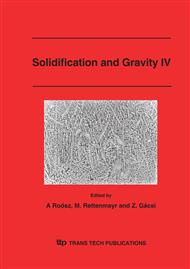p.473
p.479
p.485
p.491
p.497
p.503
p.509
p.515
p.523
Mesh-Free Simulation of Transport Phenomena in Continuous Castings of Aluminium Alloys
Abstract:
This paper introduces a general numerical scheme for solving convective-diffusive problems that appear in the solution of microscopic and macroscopic transport phenomena in continuous castings and the heat treatment of aluminium alloys. The numerical scheme is based on spatial discretisation that involves pointisation only. The solution is based on diffuse collocation with multi-quadric radial basis functions. The application of the method is demonstrated in a simplified model of a billet DC casting and verified by a comparison with the classical finite volume method.
Info:
Periodical:
Pages:
497-502
Citation:
Online since:
March 2006
Authors:
Price:
Сopyright:
© 2006 Trans Tech Publications Ltd. All Rights Reserved
Share:
Citation:


